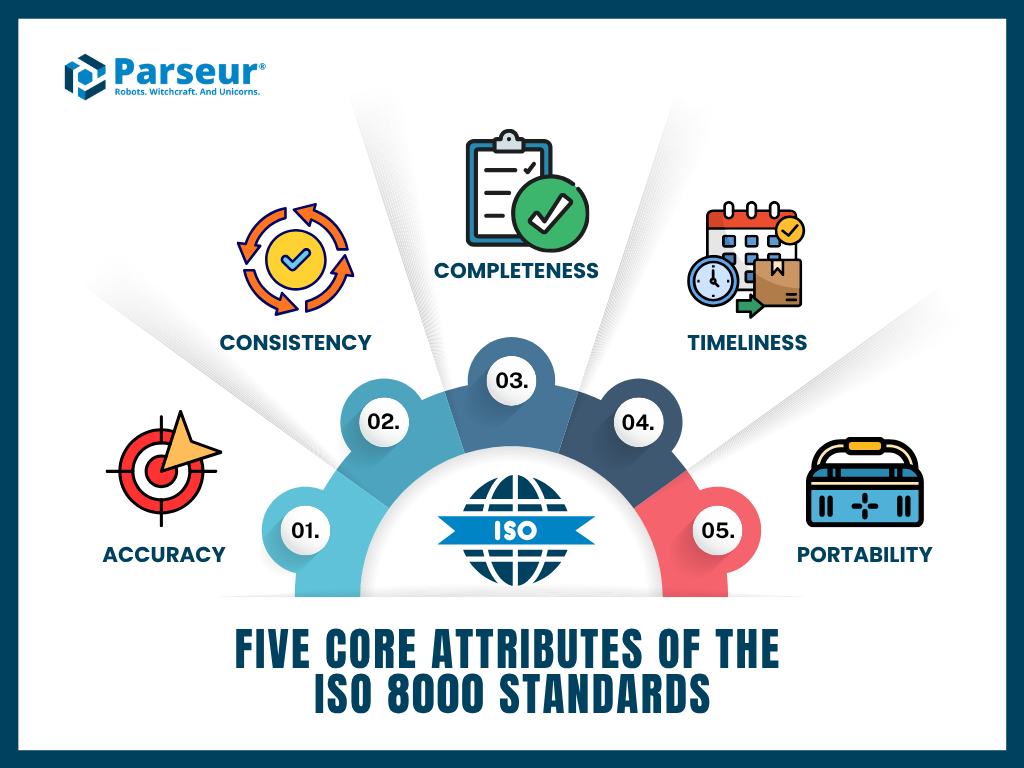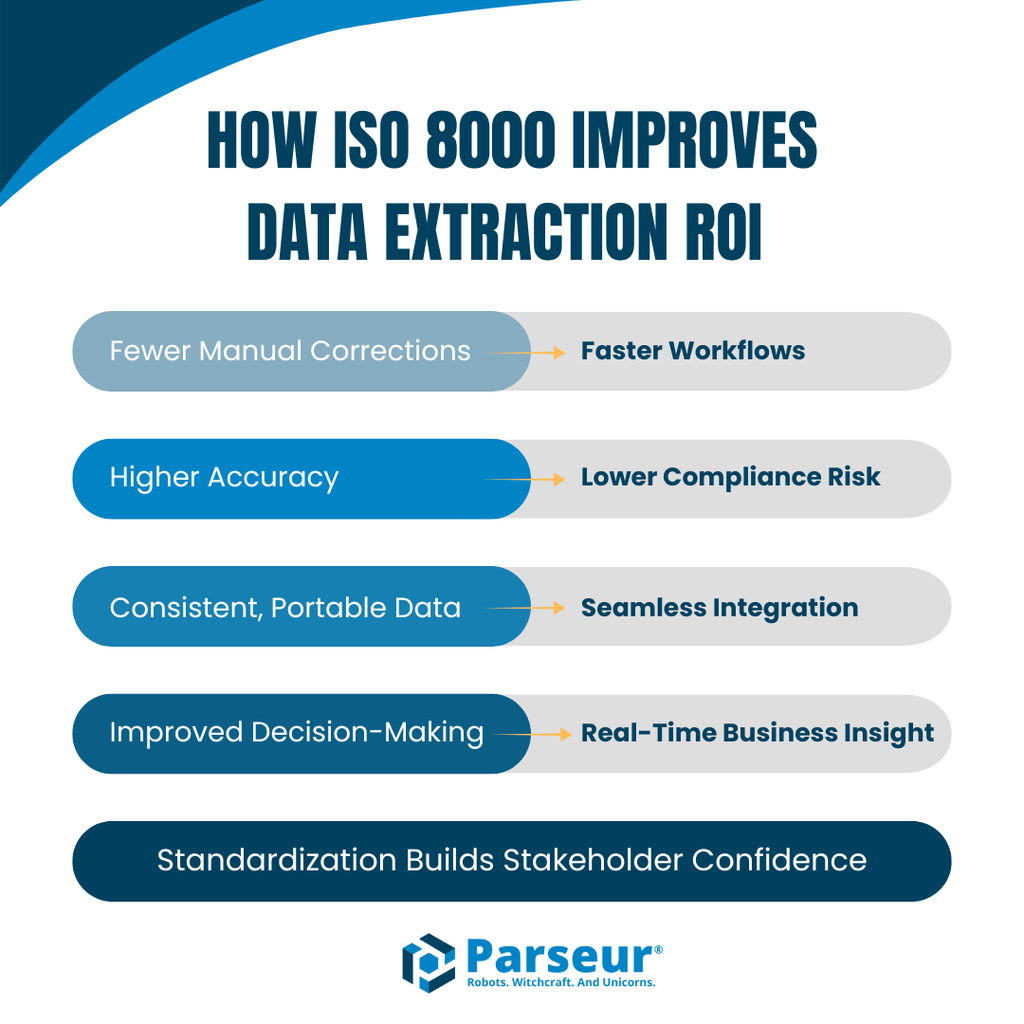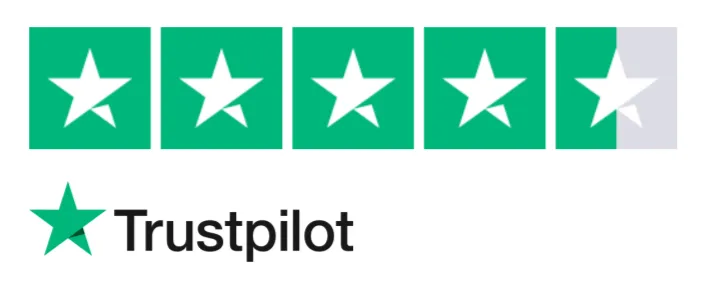What is ISO 8000?
Developed by the **International Organization for Standardization, ISO 8000 is a globally recognized framework for defining and maintaining high-quality data.
Key Takeaways:
- Quality data powers automation: ISO 8000 principles reduce errors and build trust.
- No certification needed: Parseur applies ISO-aligned workflows with AI and human validation.
- Better input, better ROI: Accurate data drives efficiency, compliance, and business value.
Why Data Quality Defines Automation Success
Imagine an AI system extracting totals from hundreds of invoices or parsing customer details from thousands of emails. However, a single mislabeled field or missing value can cause errors to cascade across accounting, compliance, or analytics. These minor inconsistencies reveal a major truth about automation: no matter how advanced AI is, poor input equals poor output.
This is the essence of the “Garbage In, Garbage Out (GIGO)” problem, and it’s especially relevant in data quality for document processing. Leverture mentions that 85% of AI projects fail, with 70% of those failures caused by poor data quality. When automation relies on messy or inconsistent inputs, accuracy, trust, and efficiency are compromised, undermining confidence in the entire system.
To solve this, organizations are aligning their automation practices with ISO 8000, the global data quality standard that defines what “good data” really means: accurate, consistent, complete, and interoperable across systems. ISO 8000 provides the foundation for organizations, enabling automation systems to produce reliable and auditable outputs.
At Parseur, while not formally ISO 8000–certified, every data extraction workflow is built on these principles. By emphasizing data validation, structured extraction, and high accuracy, Parseur ensures that automation outputs remain dependable, compliant, and ready for enterprise use.
In this era of intelligent automation, data quality defines automation success. ISO 8000 offers the framework, and Parseur operationalizes it, ensuring that every automation begins with quality data and ends with trusted outcomes.
What Is ISO 8000? The Global Standard for Data Quality
As organizations expand automation and AI adoption, one challenge consistently stands out: ensuring that the data feeding those systems is trustworthy. That’s where ISO 8000, the international standard for data quality and master data exchange, comes in.
It establishes how information should be captured, managed, and shared to remain accurate, consistent, complete, timely, and portable across systems, all essential for reliable automation.

These five core data quality attributes form the foundation of ISO 8000:
- Accuracy – Data must correctly represent real-world facts and values.
- Consistency – Information should align across datasets with no conflicts or contradictions.
- Completeness – All necessary data elements must be present and available for use.
- Timeliness – Data should always be current and accessible when needed.
- Portability – Data must remain usable across platforms, formats, and systems.
ISO 8000 is divided into multiple parts, each focusing on a key aspect of data quality management:
- ISO 8000-1: Fundamentals and vocabulary
- ISO 8000-8: Measuring data quality
- ISO 8000-61: Data quality management processes
- ISO 8000-115: Master data portability
Organizations can align their data extraction and management practices with ISO 8000 principles to ensure dependable, auditable automation even without formal certification.
For instance, Parseur’s document processing workflows already embody these principles by ensuring structured, verified, and consistent outputs that uphold enterprise-grade accuracy.
The ISO 8000 Principles In Action: Applying Them To Document Processing
While ISO 8000 may sound like a broad data management standard, its principles directly shape how reliable AI document processing and data extraction accuracy can be. When applied to automation workflows, ISO 8000 ensures that extracted data from invoices, forms, or emails is machine-readable, trustworthy, consistent, and ready for downstream use.
Below is how each ISO 8000 principle maps to real-world document automation:
| ISO 8000 Principle | Application in Document Processing | Example Use Case |
|---|---|---|
| Accuracy | AI and OCR models must correctly interpret key fields, avoiding misreads and confusion. | Extracting total amounts, tax codes, and line items from invoices with field-level precision. |
| Consistency | Standardize formats and ensure data remains uniform across all documents and integrations. | Dates are consistently formatted as ISO (YYYY-MM-DD), and currencies are standardized (USD, EUR, GBP). |
| Completeness | Capture all essential information to avoid gaps in automation workflows. | Every invoice includes the vendor name, invoice number, and total amount before processing. |
| Timeliness | Ensure extracted data is delivered quickly for actionable insights and automation triggers. | Email parsing that instantly updates ERP dashboards or accounting platforms. |
| Portability | Make data interoperable and exportable in structured, standardized formats. | JSON, CSV, or API output seamlessly integrated with Zapier, Power BI, or internal databases. |
By applying ISO 8000 in document processing, organizations create predictable, auditable, and adaptable automation pipelines in which every extracted data point can be trusted.
Why ISO 8000 Matters for Reliable AI Automation
As automation and AI become central to enterprise operations, the reliability of these systems depends entirely on data quality. ISO 8000 provides the structure and language to make that reliability measurable, turning abstract “good data” principles into auditable, actionable standards.
In AI document processing, even a single data error can cascade across systems: a misplaced decimal in an invoice, a mismatched date, or a missing vendor ID can create compliance risks and financial discrepancies. ISO 8000 prevents these issues by defining how data should be captured, formatted, verified, and exchanged, ensuring that automation delivers accurate and explainable results.
Why it matters now more than ever
- AI trust and transparency are now key to enterprise adoption.
- Regulatory pressure is growing. Data governance standards like ISO 8000 help companies stay compliant with frameworks such as GDPR and ISO 27001.
- Automation ROI depends on input integrity. Organizations aligning with ISO 8000 principles see fewer downstream errors, faster audit readiness, and stronger model performance.
By aligning data extraction workflows with ISO 8000, enterprises move from reactive error-fixing to proactive data assurance.
How Intelligent Document Processing (IDP) Tools Support ISO 8000 Alignment
Modern Intelligent Document Processing (IDP) platforms are redefining how organizations achieve ISO 8000-level data quality, not through manual compliance checklists, but through automation by design.
How Parseur aligns with ISO 8000 data quality standards
Parseur can help companies get ISO 8000 certified by enforcing data model, human in the loop, and future data validation. Its data extraction framework is built on the same five core data quality principles: Accuracy, Consistency, Completeness, Timeliness, and Portability, which define the ISO 8000 standard. Every stage of Parseur’s workflow, from document capture to export, ensures data is structured, auditable, and enterprise-ready.
- Accuracy through Intelligent Parsing
Parseur’s machine learning-driven extraction engine captures data exactly where it appears in a document, whether from structured PDFs or unstructured email bodies. This precision minimizes field-level errors and improves data reliability across use cases. Built-in automated validation rules verify totals, dates, and missing values before the data even enters your workflow, ensuring only verified information powers your automation pipeline.
- Consistency through Structured Standardization
All data extracted by Parseur adheres to a unified schema, standardizing how information is represented across multiple document types, invoices, receipts, forms, and emails. This structure ensures consistent data formats and eliminates discrepancies that often occur between sources. By removing rigid templates and adapting dynamically to layout variations, Parseur guarantees consistent results even when document formats change.
- Completeness through Human-in-the-Loop Validation
Parseur blends AI precision with human oversight, creating a hybrid approach that ensures every required field is captured, even in documents with irregular layouts or OCR-challenging elements. Template-free extraction adapts to real-world document variability, filling in gaps and maintaining completeness across all workflows. Human reviewers can easily validate and correct any outliers, feeding improvements back into the model for continuous learning.
- Timeliness through Real-Time Automation
With Parseur, data extraction and delivery happen in real time. The system parses incoming documents instantly and sends structured results directly to your ERP, CRM, or RPA systems through API-based integrations. This real-time flow eliminates manual delays, enabling faster decision-making and improving process efficiency across business operations.
- Portability through Interoperable Outputs
Parseur exports clean, structured data in multiple interoperable formats, including JSON, CSV, Excel, and Google Sheets. This ensures seamless integration with automation tools, analytics platforms, and enterprise databases. Parseur allows organizations to reuse and share high-quality data effortlessly across systems, teams, and compliance environments by meeting ISO's portability criteria.
- Auditability and Traceability by Design
Every parsed document in Parseur comes with a complete audit trail, including timestamps, user actions, and validation history (coming soon). This transparency is vital for organizations that must meet compliance, accountability, and data governance requirements. Audit-ready tracking supports ISO 8000’s emphasis on traceable, verifiable data throughout its lifecycle.
By embedding ISO 8000-aligned data quality principles into every workflow, Parseur consistently ensures speed, accuracy, and audit-ready reliability, helping enterprises confidently meet evolving data governance and compliance expectations.
Why Aligning With ISO 8000 Improves Data Extraction ROI
Data quality isn’t just a compliance measure; it’s a performance multiplier. When document processing systems align with ISO 8000 data quality standards, automation becomes faster, more reliable, and easier to extend across enterprise workflows.

1. Fewer Manual Corrections → Faster Workflows
Poor input data leads to costly rework. By applying the principles of accuracy and completeness outlined in ISO 8000, teams can drastically reduce manual verification and exception handling.
2. Higher Accuracy → Lower Compliance Risk
ISO 8000 emphasizes traceability and auditability, ensuring every extracted field can be verified.
3. Consistent, Portable Data → Seamless Integration
With standardized outputs in formats like JSON or CSV, ISO-aligned data easily flows into ERP, CRM, and BI systems without reformatting.
4. Improved Decision-Making → Real-Time Business Insight
Clean, timely data means faster reporting and better analytics. When automation outputs are trusted, leaders can make decisions confidently without second-guessing data integrity.
5. Standardization Builds Stakeholder Confidence
Whether you’re proving compliance to auditors or customer reliability, ISO-aligned data extraction demonstrates accountability and governance, turning automation trust into measurable business value.
For a deeper understanding of automation value, see Garbage In, Garbage Out: Why Bad Data Destroys Automation ROI
Common Data Extraction Pitfalls ISO 8000 Can Solve
Even the most advanced automation systems struggle without structured, reliable data. Poor-quality input can erode trust and efficiency across automated workflows from inconsistent naming to missing fields.
This is where ISO 8000 data quality standards act as a corrective framework, turning fragmented, error-prone data into consistent, traceable, and auditable information.
| Challenge | How ISO 8000 Helps | Result |
|---|---|---|
| Inconsistent naming conventions | Enforces master data reference standards under ISO 8000-115, ensuring all entities follow consistent identifiers. | Unified terminology across systems and departments. |
| Missing fields or incomplete records | Encourages completeness metrics and validation checkpoints during extraction. | Full, usable records with no data gaps. |
| Duplicate entries | Promotes the use of unique identifiers and centralized governance to prevent redundancy. | Accurate, de-duplicated datasets ready for analysis. |
| Poor formatting | Supports standardized data schemas for seamless data exchange and integration. | Clean, machine-readable data compatible with multiple systems. |
| Untraceable corrections | Requires auditability and data lineage, ensuring every modification is tracked. | Transparent, compliant records for auditing and reporting. |
The Future of Data Quality: AI Meets ISO Standards
The future of automation lies at the intersection of AI intelligence and ISO-grade data quality. As organizations rely more on machine learning for document processing and decision-making, ensuring data trust, traceability, and ethical governance will become mission-critical.
International standards are evolving rapidly to reflect this new landscape. Alongside ISO 8000 for data quality, new frameworks like ISO/IEC 42001 are emerging to govern AI management systems, addressing areas such as fairness, transparency, and accountability in automated decision-making. These standards will define how AI systems collect, process, and confirm information responsibly.
In this future, Intelligent Document Processing (IDP) will go beyond static extraction. AI will automatically detect data anomalies, predict validation errors, and self-correct before outputs reach business systems, turning compliance from a reactive process into a proactive assurance model.
Parseur is built for this next phase of automation. Its modular and auditable architecture aligns with the principles guiding ISO 8000 and emerging AI governance standards. Even as regulations evolve, every extracted dataset is designed to remain accurate, traceable, and compliant-ready. By combining human-in-the-loop validation with AI-driven data quality monitoring, Parseur bridges current data assurance needs with tomorrow’s automation ethics, helping organizations build trust, transparency, and accountability system-wide.
You Don’t Need Certification To Build ISO-Quality Data
Automation is only as good as its data. No matter how advanced your AI or document processing system is, its reliability depends on the quality of the information it receives.
While ISO 8000 sets the global benchmark for data quality, organizations don’t need formal certification to benefit from its principles. By aligning workflows with ISO 8000’s core standards: accuracy, consistency, completeness, timeliness, and portability, businesses can achieve automation that is not only fast, but verifiably reliable and auditable.
At Parseur, these principles are embedded in the design. Every data extraction workflow blends AI intelligence, structured data outputs, and a high level of accuracy to deliver ISO-grade accuracy and governance without the administrative overhead of certification.
Adopting ISO-aligned data practices today ensures your automation remains trustworthy, sustainable, and future-ready as global standards evolve.
Frequently Asked Questions
As automation and AI reshape how businesses process documents, many teams ask how ISO 8000 data quality standards support more reliable, compliant, and high-performance automation. Here’s a quick guide to the most common questions about ISO 8000, data extraction, and Parseur’s alignment with these principles.
-
What is ISO 8000 in data extraction?
-
ISO 8000 is the global standard for data quality and master data management. It ensures that data is accurate, consistent, complete, timely, and portable, which is key for automation systems that rely on structured, trusted information.
-
How does ISO 8000 improve ROI?
-
Aligning with ISO 8000 reduces rework, boosts accuracy, and speeds up data workflows. Businesses see fewer errors, faster audits, and higher automation ROI through better input integrity.
-
How does Parseur support ISO 8000?
-
Parseur operationalizes ISO 8000 principles:
- Accurate AI-driven field extraction
- Consistent structured formats
- Timely real-time data delivery
- Portable exports in CSV, JSON, and Excel
-
What’s the link between ISO 8000 and AI standards?
-
ISO 8000 ensures data quality, while ISO/IEC 42001 governs AI management and ethics. They create a framework for transparent, traceable, and trustworthy automation.
-
How can my team start applying ISO 8000?
-
Start by defining data quality metrics, standardizing formats, and adding validation rules. These steps future-proof automation against data errors and compliance risks.
-
Which industries benefit most from ISO-aligned data quality?
-
Finance, logistics, insurance, and HR see the most significant gains, where accuracy, compliance, and traceability are mission-critical. ISO 8000 ensures their automation outputs meet enterprise-grade reliability.
Last updated on




